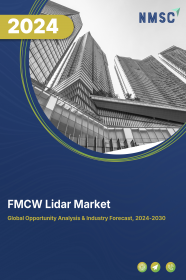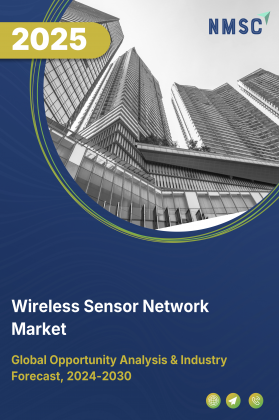
FMCW Lidar Market by Component (Laser, Photodetector, Scanner, Processor, and Other Component), by Range (Short Range, Medium Range, and Long Range), by Application (Autonomous Vehicles, Robotics and Industrial Automation, Security and Surveillance, Mapping and Surveying, and Other Application), and by End-User Industry (Automotive, Aerospace and Defense, Industrial, Consumer Electronics, Infrastructure, and Other End Users)- Global Opportunity Analysis and Industry Forecast 2024-2030
FMCW Lidar Market Overview
The FMCW Lidar Market size was valued at USD 195.0 million in 2023 and is predicted to reach USD 639.8 million by 2030 with a CAGR of 18.5% from 2024-2030. Frequency Modulated Continuous Wave (FMCW) lidar market refers to the industry that includes the development, production and distribution of advanced LiDAR systems that utilize frequency modulation to measure distance and velocity with high precision. These systems are particularly suited for applications that requires accurate real-time data, such as autonomous vehicles, industrial automation, and robotics. The market includes a variety of stakeholder, including technology developers, component manufacturers, integrators, and end users in industries where precise 3D mapping and velocity detection are critical for operations efficiently and safety.
Market Dynamics and Trends
The rising development along with the adoption of autonomous vehicle is significantly boosting the growth of the market. FMCW lidar system are essential technology in autonomous vehicles for providing precise navigation and detecting obstacles, making them crucial component in safe and efficient operation of self-driving cars.
According to a survey conducted by McKinsey & Company, autonomous driving is expected to create USD 300 billion to USD 400 billion in revenue by 2035. Also, an estimated 63.6% of registered passenger cars globally will contain partly assisted driving and steering by 2025. This surge in adoption of autonomous vehicles is further increasing the demand for advanced LiDAR technology including frequency modulated continuous wave.
Also, the global push for smart city initiatives is significantly boosting the demand for advanced sensor technologies, including FMCW LiDAR. These sensors play a crucial role in enhancing traffic management by providing accurate real-time data to optimize traffic flow and reduce congestion. They also enable precise infrastructure monitoring, helping cities maintain and manage public utilities and structures more effectively. In terms of public safety, these systems offer superior detection capabilities for monitoring urban spaces, ensuring quick response to potential threats or incidents. As cities strive to become smarter and more efficient, the adoption of such technology is becoming essential to support these advancements.
Additionally, rising technological advancement in LiDAR technology for improved resolution, range and reliability are further fuelling the growth of the market. For instance, in January 2024, Aeva launched Atlas FMCW LiDAR sensor featuring advanced frequency- modulated continuous technology, providing high-resolutions and accurate distance measurements crucial for autonomous vehicles. These advancements improve the applicability of FMCW LiDAR systems in diverse field, from autonomous vehicles to smart city infrastructure, boosting the FMCW lidar market growth.
However, FMCW LiDAR technology is still under development compared to ToF LiDAR. This translates to higher research & development costs, making it a less mature and potentially more expensive solution for manufacturers, thus restraining the growth of the market.
On the other hand, the introduction of photonic integrated circuit (PIC) based FMCW lidar is expected to create ample growth opportunities for the market in the future. This system use integrated photonic circuits to miniaturize the lidar sensor and improve its performance. It is expected to be particularly useful in applications such as autonomous vehicles and robotics.
Market Segmentation and Scope of Study
The global FMCW lidar market report is segmented on the basis of component, application, and region. Based on product component, the market is classified into laser, inertial navigation system, camera, Gps/Gnss receiver, and micro electro mechanical system (MEMS). On the basis of application, the market is categorized into automotive, aerospace & defense, robotics, and others. Regional breakdown and analysis of each of the aforesaid classifications include regions comprising of North America, Europe, Asia-Pacific, and RoW.
Geographical Analysis
North America dominates the global FMCW lidar market trends and is potently expected to remain dominant in the market throughout the forecast period. This is attributed to the increasing adoption of autonomous vehicles in various countries including the U.S. and Canada. Autonomous vehicles rely heavily on advanced sensor technologies to navigate and operate safely. FMCW LiDAR systems are crucial for these vehicles as these sensors provide high-resolution, real-time data on the vehicle's surroundings, including accurate distance measurements and obstacle detection. According to the Insurance Institute for Highway Safety report, an estimated 3.5 million self-driving vehicle is expected on U.S. roads by 2025, and 4.5 million by 2030. This rising trend accelerates the adoption of these sensors and contributing to advancements in autonomous driving capabilities across the region.
Furthermore, the growing trend of industrial automation in North America is significantly driving the FMCW lidar market demand due to the increasing need for advanced sensing technologies that enhance operational efficiency and safety. According to the International Federation of Robotics Report as of May 2023, robotics market is significantly growing in the North American region. Total number of installations in the manufacturing sector rose by 12% and reached 41,624 units in 2022. Also, the automotive industry is dominating in the region with 20,391 units of industrial robots’ adoption in the sector, registering a growth of 30% compared to 2021. As industries adopt automated systems for tasks such as real-time monitoring, quality control, and predictive maintenance, FMCW LiDAR systems become crucial for providing high-resolution and accurate data. These systems improve precision in robotic operations, streamline material handling, and ensure better safety through reliable obstacle detection.
On the other hand, Asia Pacific shows substantial growth in the global market owing to growing smart city initiatives in countries such as China, Japan, and India by increasing the demand for advanced sensor technologies. For instance, China’s smart city initiative known as “Made in China 2025” is boosting the adoption highly automated and digitized manufacturing facilities to shift China from a low-cost manufacturing centre to a global leader in advanced manufacturing technologies. These initiatives focus on integrating technology into urban infrastructure to enhance traffic management, public safety, manufacturing facilities, and environmental monitoring. FMCW LiDAR systems provide the precise and reliable data needed for these applications, making them essential for developing smart city solutions.
Additionally, the increasing military and defence investment are further boosting the demand for FMCW LiDAR technology as these sensors are crucial for enhancing surveillance, reconnaissance, and autonomous systems. Countries such as China and India are investing heavily in modernizing their defence capabilities, that includes integrating sophisticated technologies including FMCW LiDAR for better detection, targeting, and situational awareness. As per the International Institute for Strategic Studies, China’s defence budget surged to USD 236 billion in 2024, compared to an estimated USD 298 billion spent by all of Asia combined. This drive for advanced defence technology is fuelling the demand for FMCW LiDAR systems to support next-generation military applications and improve operational efficiency.
Competitive Landscape
Various key players operating in the FMCW lidar industry include Scantinel Photonics, SiLC Technologies, Aeva Technologies, Inc., Analog Photonics, Leishen Intelligent System, LuminWave, Blackmore Sensors and Analytics, Insight's Digital Coherent LiDAR, Valeo, Bridger Photonics, Panasonic Corporation, Siviers Semiconductors AB, Epic Photonics, StereoVision Imaging, Voyant Photonics. These market players are adopting various strategies such as product launch and collaboration to maintain their dominance in the global market.
For instance, in April 2024, Quanergy launched next-generation 3D LiDAR solutions with the introduction of the Q-Track HD and Q-Track Dome. These new models offered enhanced resolution and coverage, advancing the FMCW LiDAR technology by providing more versatile and precise LiDAR solutions for various applications, including smart cities and autonomous vehicles.
Also, in February 2024, LuminWave collaborated with GWM to advance FMCW LiDAR technology. This partnership aimed to integrate LuminWave's LiDAR solutions with GWM's automotive platforms, enhancing vehicle perception and safety features. This collaboration contributed to the FMCW LiDAR industry by facilitating the development and deployment of advanced LiDAR systems in automotive applications.
Moreover, in June 2023, Scantinel Photonics launched second-generation FMCW LiDAR silicon chip, marking a significant breakthrough in LiDAR technology. The new chip features advanced frequency-modulated continuous wave (FMCW) capabilities, providing enhanced accuracy and resolution while being more compact and cost-effective compared to previous generations.
Key Benefits
-
The report provides quantitative analysis and estimations of the market from 2024 to 2030, which assists in identifying the prevailing market opportunities.
-
The study comprises a deep-dive analysis of the current and future FMCW Lidar market trends to depict prevalent investment pockets in the market.
-
Information related to key drivers, restraints, and opportunities and their impact on the market is provided in the report.
-
Competitive analysis of the players, along with their market share is provided in the report.
-
Value chain analysis in the market study provides a clear picture of roles of stakeholders.
FMCW Lidar Market Key Segments
By Component
-
Laser
-
Photodetector
-
Scanner
-
Processor
-
Other Component
By Range
-
Short Range
-
Medium Range
-
Long Range
By Application
-
Autonomous Vehicles
-
Robotics and Industrial Automation
-
Security and Surveillance
-
Mapping and Surveying
-
Other Application
By End-User Industry
-
Automotive
-
Aerospace and Defense
-
Industrial
-
Consumer Electronics
-
Infrastructure
-
Other End Users
By Region
-
North America
-
The U.S.
-
Canada
-
Mexico
-
-
Europe
-
The UK
-
Germany
-
France
-
Italy
-
Spain
-
Denmark
-
Netherlands
-
Finland
-
Sweden
-
Norway
-
Russia
-
Rest of Europe
-
-
Asia-Pacific
-
China
-
Japan
-
India
-
South Korea
-
Australia
-
Indonesia
-
Singapore
-
Taiwan
-
Thailand
-
Rest of Asia-Pacific
-
-
RoW
-
Latin America
-
Middle East
-
Africa
-
REPORT SCOPE AND SEGMENTATION:
|
Parameters |
Details |
|
Market Size in 2023 |
USD 195.0 Million |
|
Revenue Forecast in 2030 |
USD 639.8 Million |
|
Growth Rate |
18.5% from 2024 to 2030 |
|
Analysis Period |
2023–2030 |
|
Base Year Considered |
2023 |
|
Forecast Period |
2024–2030 |
|
Market Size Estimation |
Million (USD) |
|
Growth Factors |
|
|
Countries Covered |
28 |
|
Companies Profiled |
15 |
|
Market Share |
Available for 10 companies |
|
Customization Scope |
Free customization (equivalent to up to 80 working hours of analysts) after purchase. Addition or alteration to country, regional, and segment scope. |
|
Pricing and Purchase Options |
Avail customized purchase options to meet your exact research needs. |
KEY PLAYERS
-
Scantinel Photonics
-
SiLC Technologies
-
Aeva Technologies, Inc.
-
Analog Photonics
-
Leishen Intelligent System
-
LuminWave
-
Blackmore Sensors and Analytics
-
Insight's Digital Coherent LiDAR
-
Valeo
-
Bridger Photonics
-
Panasonic Corporation
-
Siviers Semiconductors AB
-
Epic Photonics
-
StereoVision Imaging
-
Voyant Photonics




















 Speak to Our Analyst
Speak to Our Analyst

























